FORD F650 2005 11.G Owners Manual
Manufacturer: FORD, Model Year: 2005, Model line: F650, Model: FORD F650 2005 11.GPages: 272, PDF Size: 1.5 MB
Page 171 of 272
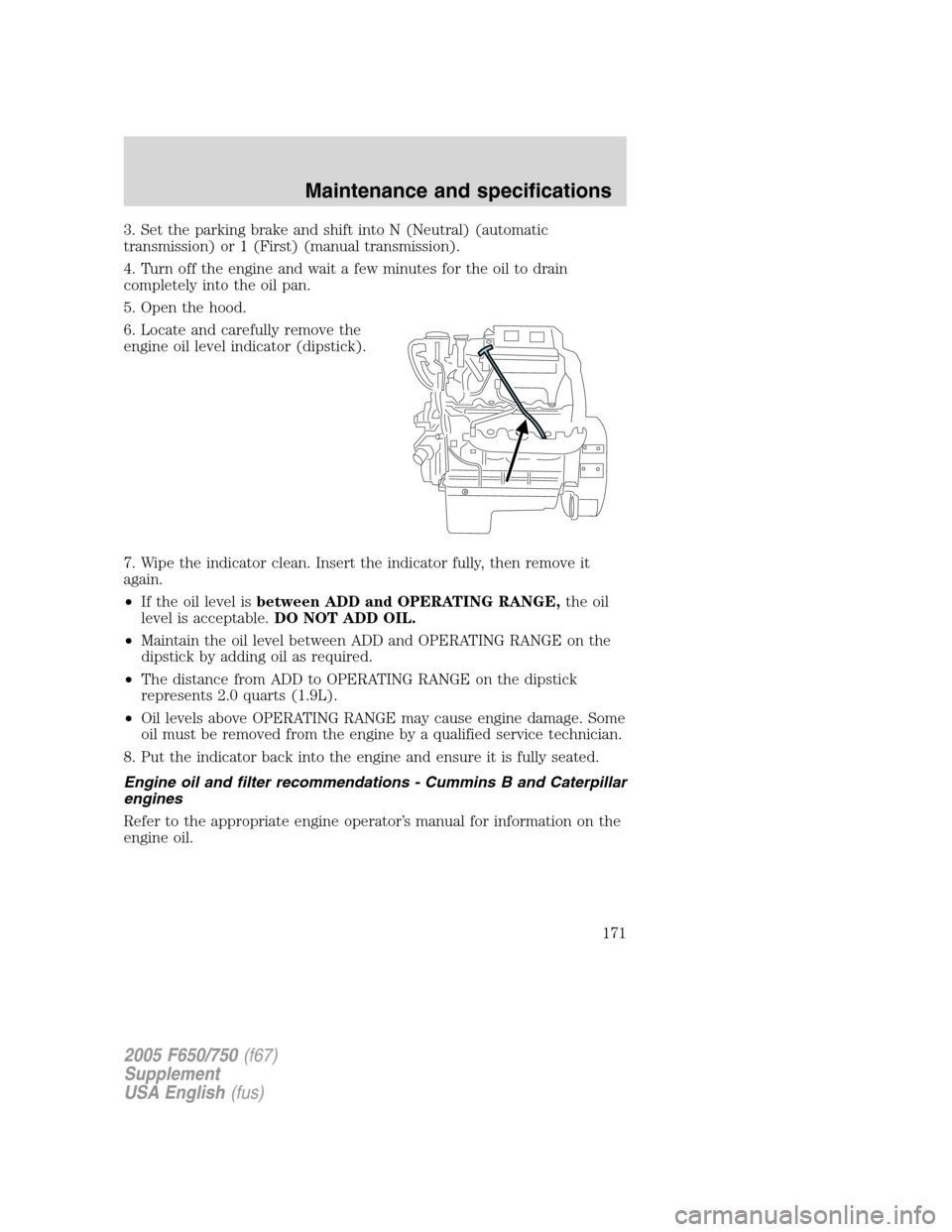
3. Set the parking brake and shift into N (Neutral) (automatic
transmission) or 1 (First) (manual transmission).
4. Turn off the engine and wait a few minutes for the oil to drain
completely into the oil pan.
5. Open the hood.
6. Locate and carefully remove the
engine oil level indicator (dipstick).
7. Wipe the indicator clean. Insert the indicator fully, then remove it
again.
•If the oil level isbetween ADD and OPERATING RANGE,the oil
level is acceptable.DO NOT ADD OIL.
•Maintain the oil level between ADD and OPERATING RANGE on the
dipstick by adding oil as required.
•The distance from ADD to OPERATING RANGE on the dipstick
represents 2.0 quarts (1.9L).
•Oil levels above OPERATING RANGE may cause engine damage. Some
oil must be removed from the engine by a qualified service technician.
8. Put the indicator back into the engine and ensure it is fully seated.
Engine oil and filter recommendations - Cummins B and Caterpillar
engines
Refer to the appropriate engine operator’s manual for information on the
engine oil.
2005 F650/750(f67)
Supplement
USA English(fus)
Maintenance and specifications
171
Page 172 of 272
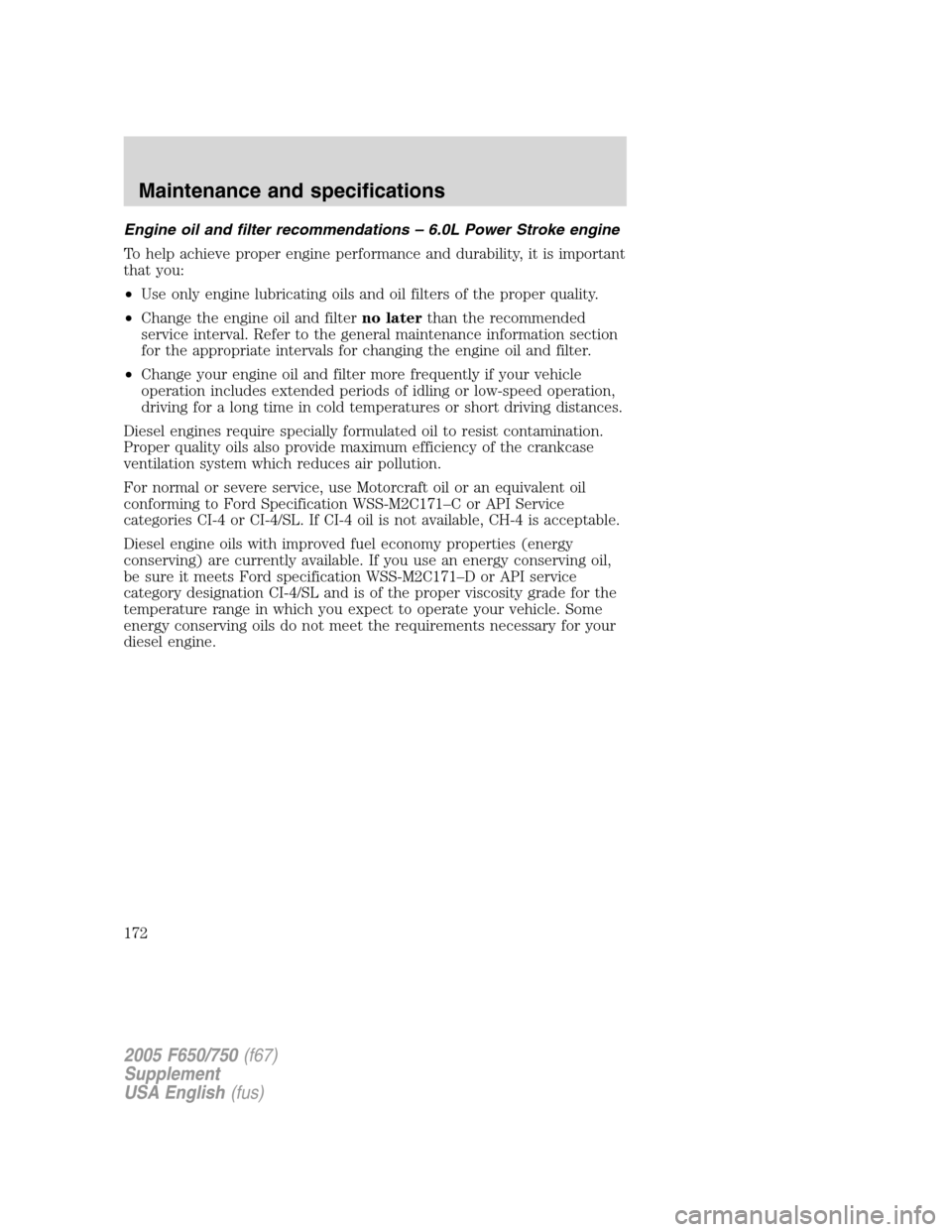
Engine oil and filter recommendations–6.0L Power Stroke engine
To help achieve proper engine performance and durability, it is important
that you:
•Use only engine lubricating oils and oil filters of the proper quality.
•Change the engine oil and filterno laterthan the recommended
service interval. Refer to the general maintenance information section
for the appropriate intervals for changing the engine oil and filter.
•Change your engine oil and filter more frequently if your vehicle
operation includes extended periods of idling or low-speed operation,
driving for a long time in cold temperatures or short driving distances.
Diesel engines require specially formulated oil to resist contamination.
Proper quality oils also provide maximum efficiency of the crankcase
ventilation system which reduces air pollution.
For normal or severe service, use Motorcraft oil or an equivalent oil
conforming to Ford Specification WSS-M2C171–C or API Service
categories CI-4 or CI-4/SL. If CI-4 oil is not available, CH-4 is acceptable.
Diesel engine oils with improved fuel economy properties (energy
conserving) are currently available. If you use an energy conserving oil,
be sure it meets Ford specification WSS-M2C171–D or API service
category designation CI-4/SL and is of the proper viscosity grade for the
temperature range in which you expect to operate your vehicle. Some
energy conserving oils do not meet the requirements necessary for your
diesel engine.
2005 F650/750(f67)
Supplement
USA English(fus)
Maintenance and specifications
172
Page 173 of 272
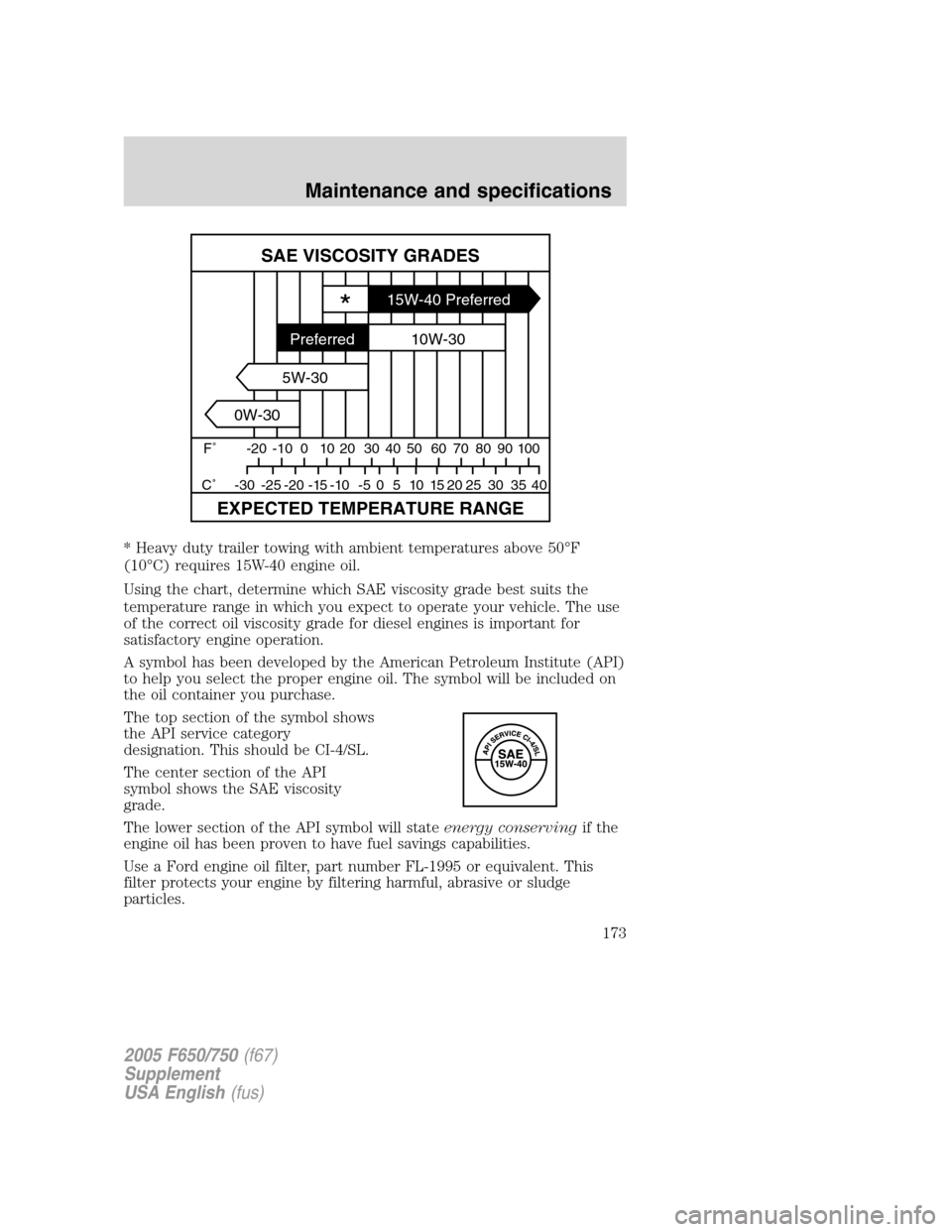
* Heavy duty trailer towing with ambient temperatures above 50°F
(10°C) requires 15W-40 engine oil.
Using the chart, determine which SAE viscosity grade best suits the
temperature range in which you expect to operate your vehicle. The use
of the correct oil viscosity grade for diesel engines is important for
satisfactory engine operation.
A symbol has been developed by the American Petroleum Institute (API)
to help you select the proper engine oil. The symbol will be included on
the oil container you purchase.
The top section of the symbol shows
the API service category
designation. This should be CI-4/SL.
The center section of the API
symbol shows the SAE viscosity
grade.
The lower section of the API symbol will stateenergy conservingif the
engine oil has been proven to have fuel savings capabilities.
Use a Ford engine oil filter, part number FL-1995 or equivalent. This
filter protects your engine by filtering harmful, abrasive or sludge
particles.
SAE VISCOSITY GRADES
EXPECTED TEMPERATURE RANGE
F˚ -20 -10 0 10 20 30 40
40 35 30 25 20 15 10 5 0 -5 -10 -15 -20 -25 -30 C˚50 60 70 80 90 100
*15W-40 Preferred
10W-30
5W-30
0W-30Preferred
2005 F650/750(f67)
Supplement
USA English(fus)
Maintenance and specifications
173
Page 174 of 272
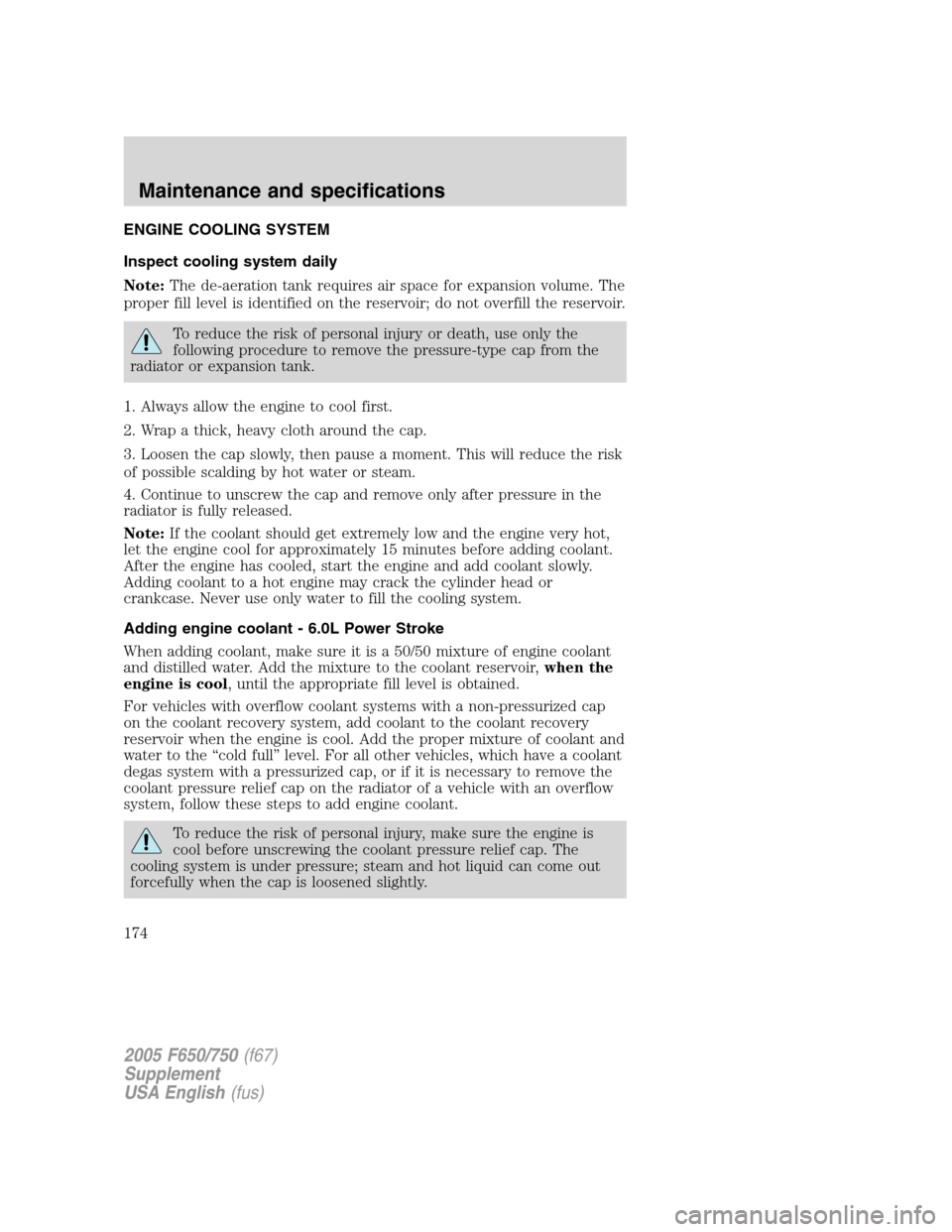
ENGINE COOLING SYSTEM
Inspect cooling system daily
Note:The de-aeration tank requires air space for expansion volume. The
proper fill level is identified on the reservoir; do not overfill the reservoir.
To reduce the risk of personal injury or death, use only the
following procedure to remove the pressure-type cap from the
radiator or expansion tank.
1. Always allow the engine to cool first.
2. Wrap a thick, heavy cloth around the cap.
3. Loosen the cap slowly, then pause a moment. This will reduce the risk
of possible scalding by hot water or steam.
4. Continue to unscrew the cap and remove only after pressure in the
radiator is fully released.
Note:If the coolant should get extremely low and the engine very hot,
let the engine cool for approximately 15 minutes before adding coolant.
After the engine has cooled, start the engine and add coolant slowly.
Adding coolant to a hot engine may crack the cylinder head or
crankcase. Never use only water to fill the cooling system.
Adding engine coolant - 6.0L Power Stroke
When adding coolant, make sure it is a 50/50 mixture of engine coolant
and distilled water. Add the mixture to the coolant reservoir,when the
engine is cool, until the appropriate fill level is obtained.
For vehicles with overflow coolant systems with a non-pressurized cap
on the coolant recovery system, add coolant to the coolant recovery
reservoir when the engine is cool. Add the proper mixture of coolant and
water to the“cold full”level. For all other vehicles, which have a coolant
degas system with a pressurized cap, or if it is necessary to remove the
coolant pressure relief cap on the radiator of a vehicle with an overflow
system, follow these steps to add engine coolant.
To reduce the risk of personal injury, make sure the engine is
cool before unscrewing the coolant pressure relief cap. The
cooling system is under pressure; steam and hot liquid can come out
forcefully when the cap is loosened slightly.
2005 F650/750(f67)
Supplement
USA English(fus)
Maintenance and specifications
174
Page 175 of 272
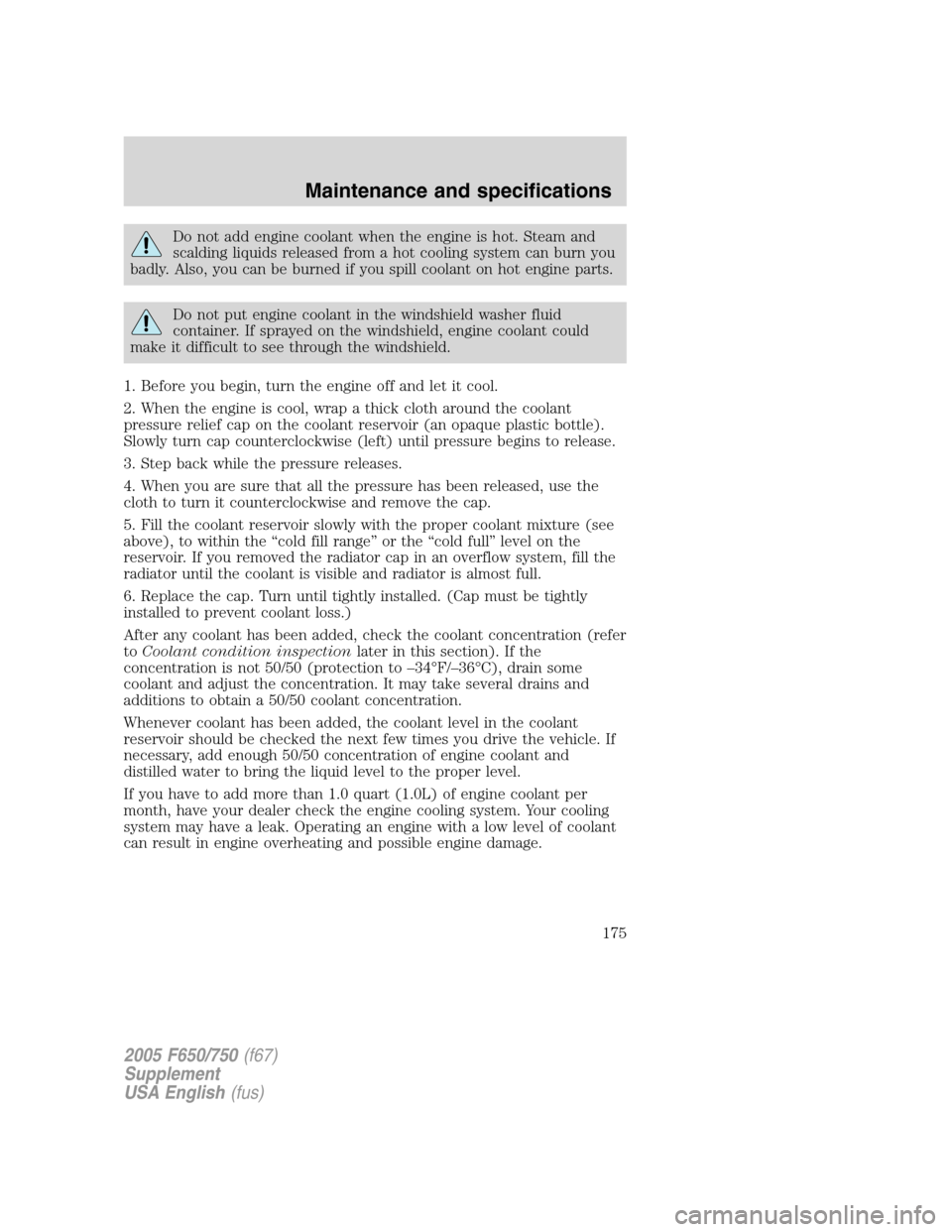
Do not add engine coolant when the engine is hot. Steam and
scalding liquids released from a hot cooling system can burn you
badly. Also, you can be burned if you spill coolant on hot engine parts.
Do not put engine coolant in the windshield washer fluid
container. If sprayed on the windshield, engine coolant could
make it difficult to see through the windshield.
1. Before you begin, turn the engine off and let it cool.
2. When the engine is cool, wrap a thick cloth around the coolant
pressure relief cap on the coolant reservoir (an opaque plastic bottle).
Slowly turn cap counterclockwise (left) until pressure begins to release.
3. Step back while the pressure releases.
4. When you are sure that all the pressure has been released, use the
cloth to turn it counterclockwise and remove the cap.
5. Fill the coolant reservoir slowly with the proper coolant mixture (see
above), to within the“cold fill range”or the“cold full”level on the
reservoir. If you removed the radiator cap in an overflow system, fill the
radiator until the coolant is visible and radiator is almost full.
6. Replace the cap. Turn until tightly installed. (Cap must be tightly
installed to prevent coolant loss.)
After any coolant has been added, check the coolant concentration (refer
toCoolant condition inspectionlater in this section). If the
concentration is not 50/50 (protection to–34°F/–36°C), drain some
coolant and adjust the concentration. It may take several drains and
additions to obtain a 50/50 coolant concentration.
Whenever coolant has been added, the coolant level in the coolant
reservoir should be checked the next few times you drive the vehicle. If
necessary, add enough 50/50 concentration of engine coolant and
distilled water to bring the liquid level to the proper level.
If you have to add more than 1.0 quart (1.0L) of engine coolant per
month, have your dealer check the engine cooling system. Your cooling
system may have a leak. Operating an engine with a low level of coolant
can result in engine overheating and possible engine damage.
2005 F650/750(f67)
Supplement
USA English(fus)
Maintenance and specifications
175
Page 176 of 272
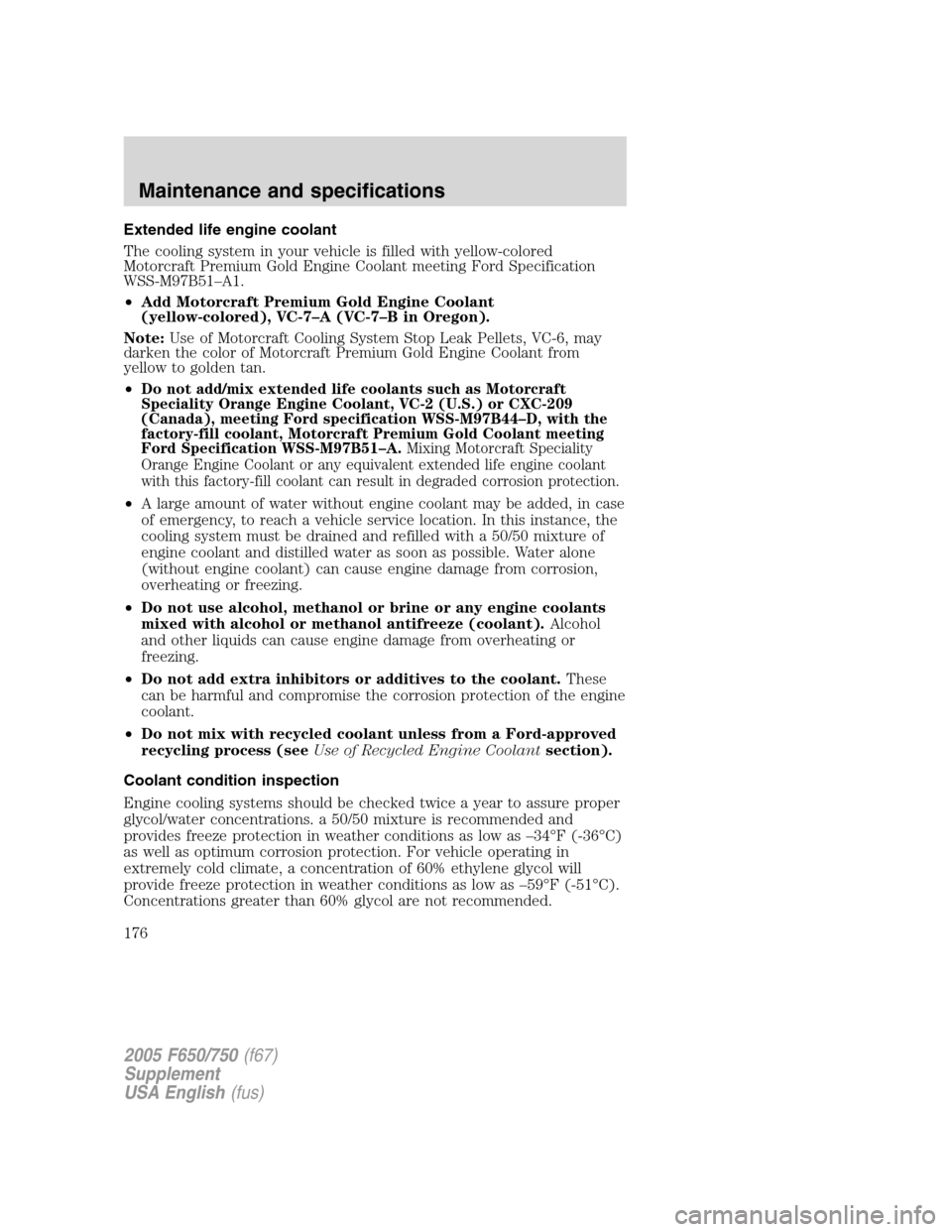
Extended life engine coolant
The cooling system in your vehicle is filled with yellow-colored
Motorcraft Premium Gold Engine Coolant meeting Ford Specification
WSS-M97B51–A1.
•Add Motorcraft Premium Gold Engine Coolant
(yellow-colored), VC-7–A (VC-7–B in Oregon).
Note:Use of Motorcraft Cooling System Stop Leak Pellets, VC-6, may
darken the color of Motorcraft Premium Gold Engine Coolant from
yellow to golden tan.
•
Do not add/mix extended life coolants such as Motorcraft
Speciality Orange Engine Coolant, VC-2 (U.S.) or CXC-209
(Canada), meeting Ford specification WSS-M97B44–D, with the
factory-fill coolant, Motorcraft Premium Gold Coolant meeting
Ford Specification WSS-M97B51–A.Mixing Motorcraft Speciality
Orange Engine Coolant or any equivalent extended life engine coolant
with this factory-fill coolant can result in degraded corrosion protection.
•A large amount of water without engine coolant may be added, in case
of emergency, to reach a vehicle service location. In this instance, the
cooling system must be drained and refilled with a 50/50 mixture of
engine coolant and distilled water as soon as possible. Water alone
(without engine coolant) can cause engine damage from corrosion,
overheating or freezing.
•Do not use alcohol, methanol or brine or any engine coolants
mixed with alcohol or methanol antifreeze (coolant).Alcohol
and other liquids can cause engine damage from overheating or
freezing.
•Do not add extra inhibitors or additives to the coolant.These
can be harmful and compromise the corrosion protection of the engine
coolant.
•Do not mix with recycled coolant unless from a Ford-approved
recycling process (seeUse of Recycled Engine Coolantsection).
Coolant condition inspection
Engine cooling systems should be checked twice a year to assure proper
glycol/water concentrations. a 50/50 mixture is recommended and
provides freeze protection in weather conditions as low as–34°F (-36°C)
as well as optimum corrosion protection. For vehicle operating in
extremely cold climate, a concentration of 60% ethylene glycol will
provide freeze protection in weather conditions as low as–59°F (-51°C).
Concentrations greater than 60% glycol are not recommended.
2005 F650/750(f67)
Supplement
USA English(fus)
Maintenance and specifications
176
Page 177 of 272
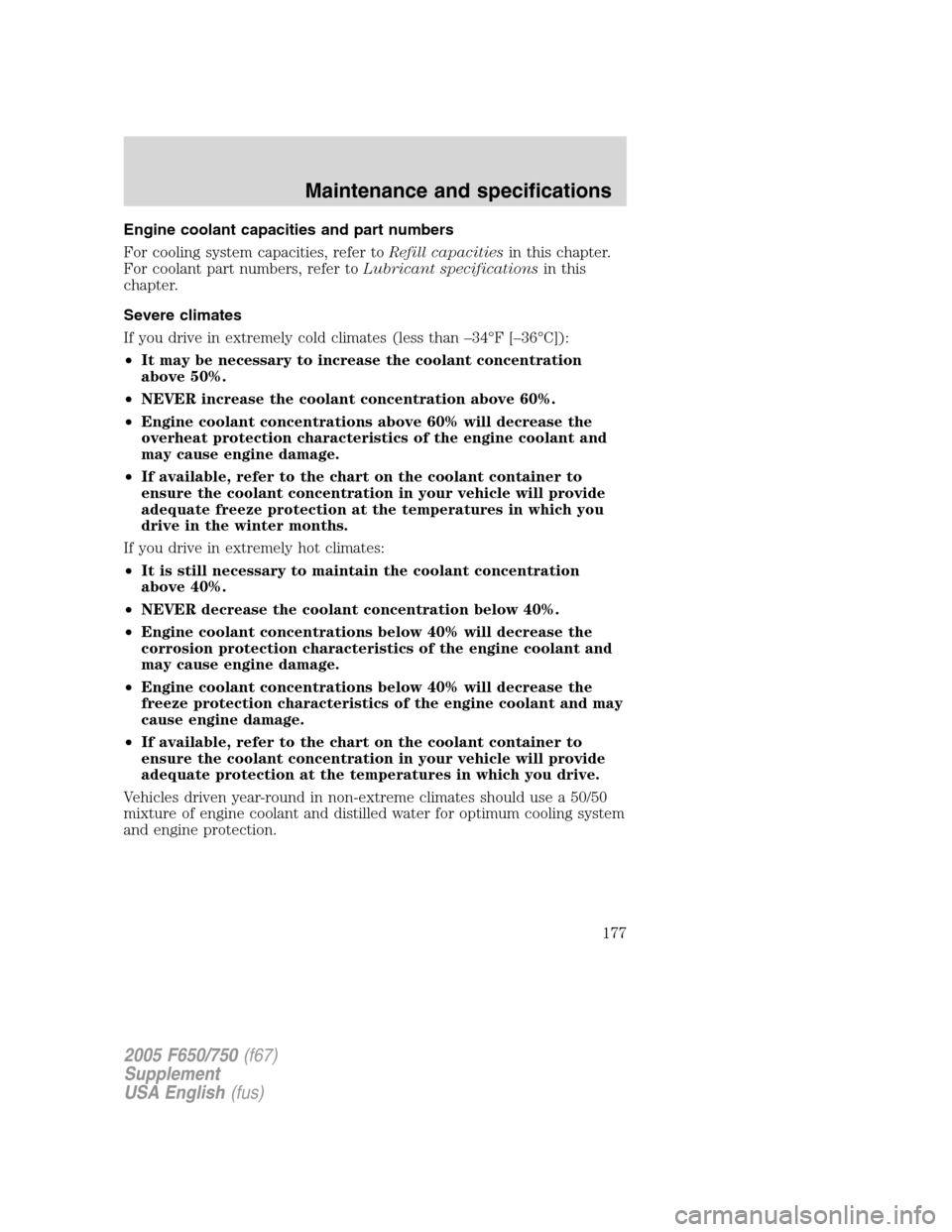
Engine coolant capacities and part numbers
For cooling system capacities, refer toRefill capacitiesin this chapter.
For coolant part numbers, refer toLubricant specificationsin this
chapter.
Severe climates
If you drive in extremely cold climates (less than–34°F[–36°C]):
•It may be necessary to increase the coolant concentration
above 50%.
•NEVER increase the coolant concentration above 60%.
•Engine coolant concentrations above 60% will decrease the
overheat protection characteristics of the engine coolant and
may cause engine damage.
•If available, refer to the chart on the coolant container to
ensure the coolant concentration in your vehicle will provide
adequate freeze protection at the temperatures in which you
drive in the winter months.
If you drive in extremely hot climates:
•It is still necessary to maintain the coolant concentration
above 40%.
•NEVER decrease the coolant concentration below 40%.
•Engine coolant concentrations below 40% will decrease the
corrosion protection characteristics of the engine coolant and
may cause engine damage.
•Engine coolant concentrations below 40% will decrease the
freeze protection characteristics of the engine coolant and may
cause engine damage.
•If available, refer to the chart on the coolant container to
ensure the coolant concentration in your vehicle will provide
adequate protection at the temperatures in which you drive.
Vehicles driven year-round in non-extreme climates should use a 50/50
mixture of engine coolant and distilled water for optimum cooling system
and engine protection.
2005 F650/750(f67)
Supplement
USA English(fus)
Maintenance and specifications
177
Page 178 of 272
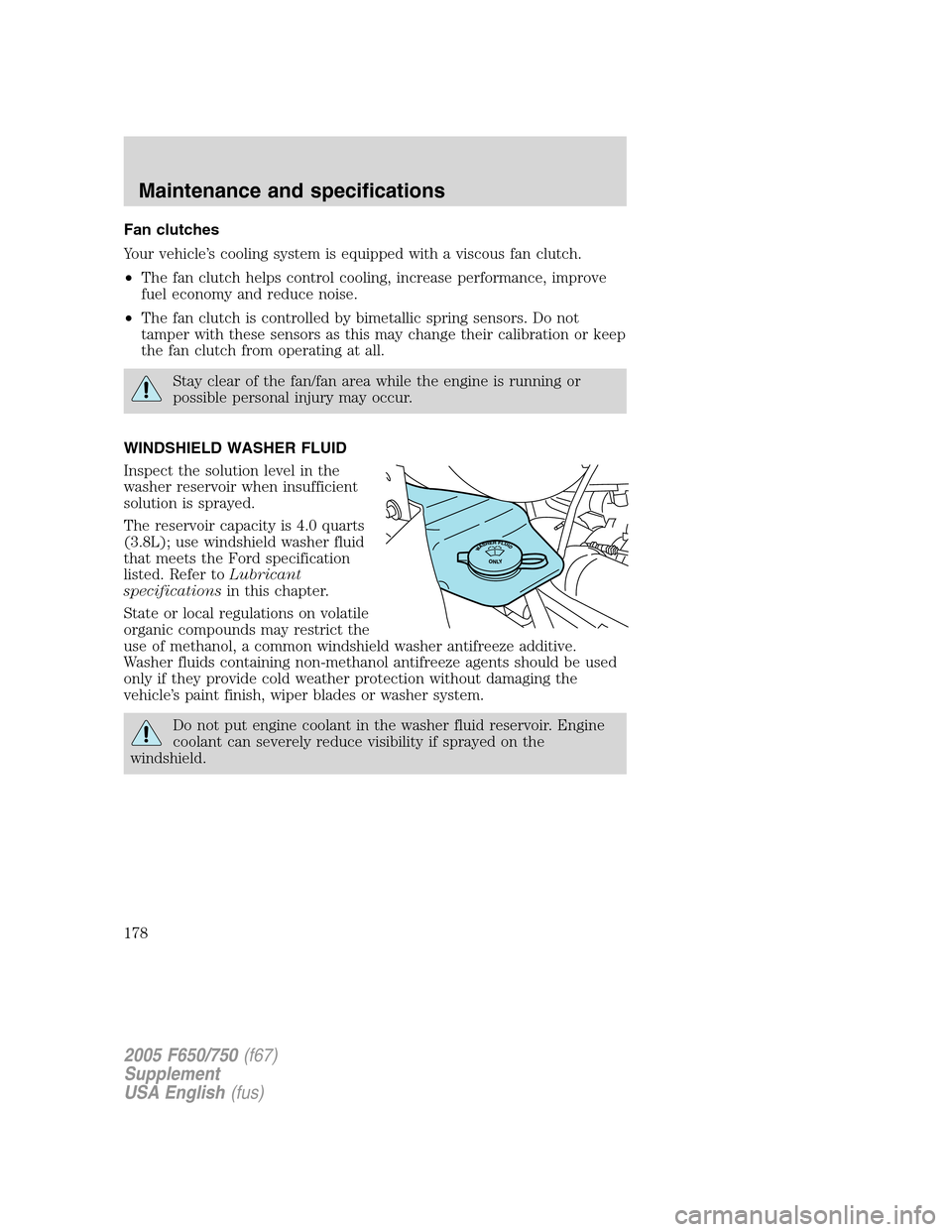
Fan clutches
Your vehicle’s cooling system is equipped with a viscous fan clutch.
•The fan clutch helps control cooling, increase performance, improve
fuel economy and reduce noise.
•The fan clutch is controlled by bimetallic spring sensors. Do not
tamper with these sensors as this may change their calibration or keep
the fan clutch from operating at all.
Stay clear of the fan/fan area while the engine is running or
possible personal injury may occur.
WINDSHIELD WASHER FLUID
Inspect the solution level in the
washer reservoir when insufficient
solution is sprayed.
The reservoir capacity is 4.0 quarts
(3.8L); use windshield washer fluid
that meets the Ford specification
listed. Refer toLubricant
specificationsin this chapter.
State or local regulations on volatile
organic compounds may restrict the
use of methanol, a common windshield washer antifreeze additive.
Washer fluids containing non-methanol antifreeze agents should be used
only if they provide cold weather protection without damaging the
vehicle’s paint finish, wiper blades or washer system.
Do not put engine coolant in the washer fluid reservoir. Engine
coolant can severely reduce visibility if sprayed on the
windshield.
2005 F650/750(f67)
Supplement
USA English(fus)
Maintenance and specifications
178
Page 179 of 272
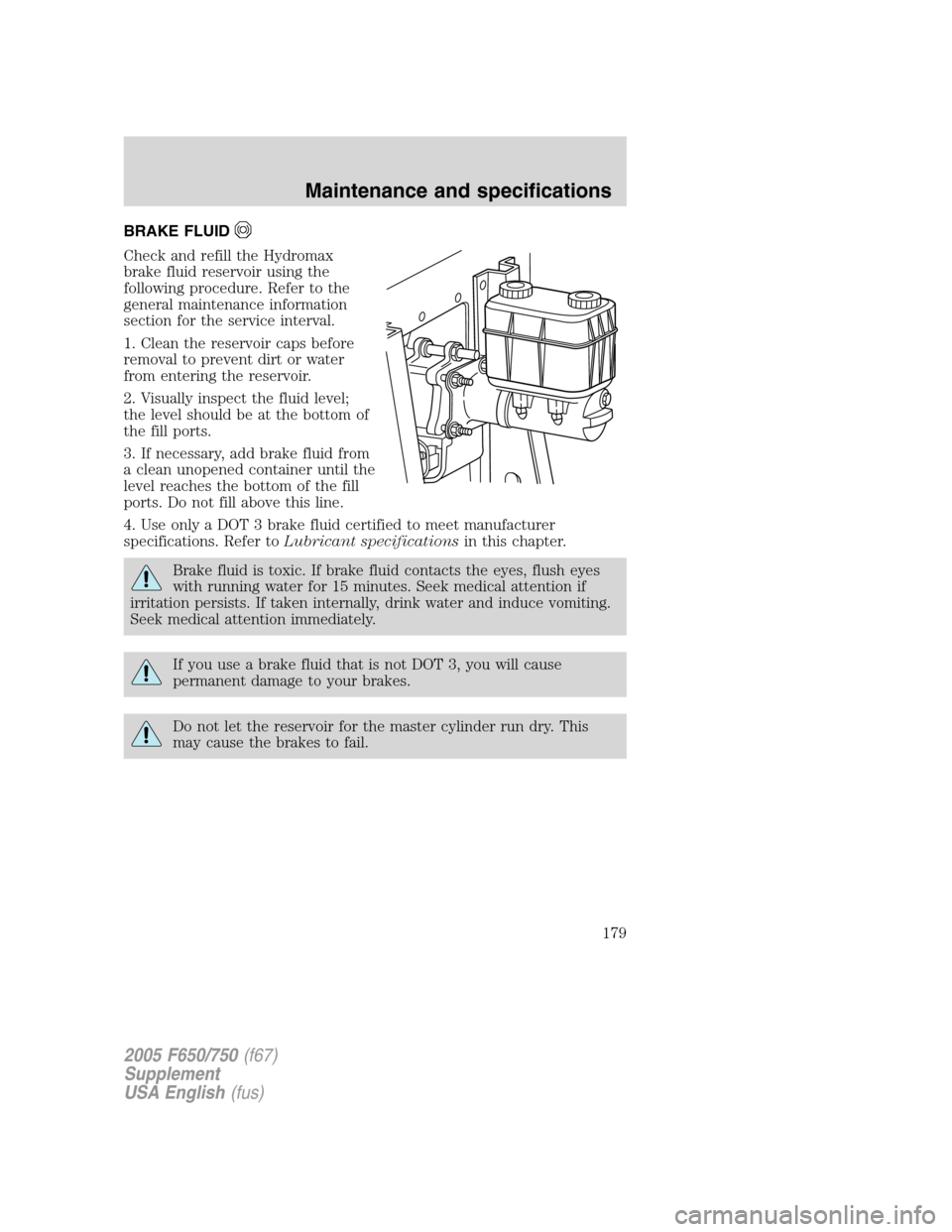
BRAKE FLUID
Check and refill the Hydromax
brake fluid reservoir using the
following procedure. Refer to the
general maintenance information
section for the service interval.
1. Clean the reservoir caps before
removal to prevent dirt or water
from entering the reservoir.
2. Visually inspect the fluid level;
the level should be at the bottom of
the fill ports.
3. If necessary, add brake fluid from
a clean unopened container until the
level reaches the bottom of the fill
ports. Do not fill above this line.
4. Use only a DOT 3 brake fluid certified to meet manufacturer
specifications. Refer toLubricant specificationsin this chapter.
Brake fluid is toxic. If brake fluid contacts the eyes, flush eyes
with running water for 15 minutes. Seek medical attention if
irritation persists. If taken internally, drink water and induce vomiting.
Seek medical attention immediately.
If you use a brake fluid that is not DOT 3, you will cause
permanent damage to your brakes.
Do not let the reservoir for the master cylinder run dry. This
may cause the brakes to fail.
2005 F650/750(f67)
Supplement
USA English(fus)
Maintenance and specifications
179
Page 180 of 272
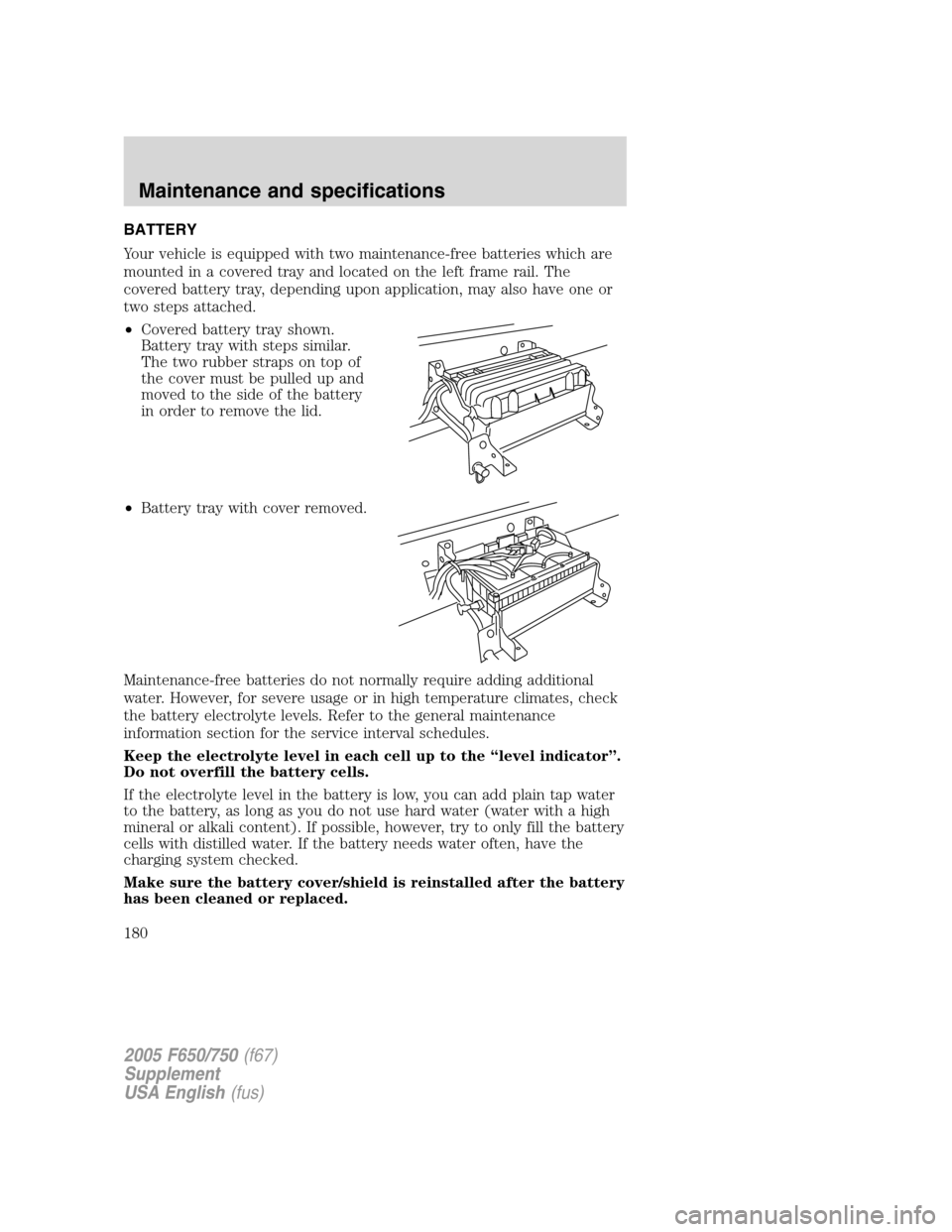
BATTERY
Your vehicle is equipped with two maintenance-free batteries which are
mounted in a covered tray and located on the left frame rail. The
covered battery tray, depending upon application, may also have one or
two steps attached.
•Covered battery tray shown.
Battery tray with steps similar.
The two rubber straps on top of
the cover must be pulled up and
moved to the side of the battery
in order to remove the lid.
•Battery tray with cover removed.
Maintenance-free batteries do not normally require adding additional
water. However, for severe usage or in high temperature climates, check
the battery electrolyte levels. Refer to the general maintenance
information section for the service interval schedules.
Keep the electrolyte level in each cell up to the“level indicator”.
Do not overfill the battery cells.
If the electrolyte level in the battery is low, you can add plain tap water
to the battery, as long as you do not use hard water (water with a high
mineral or alkali content). If possible, however, try to only fill the battery
cells with distilled water. If the battery needs water often, have the
charging system checked.
Make sure the battery cover/shield is reinstalled after the battery
has been cleaned or replaced.
2005 F650/750(f67)
Supplement
USA English(fus)
Maintenance and specifications
180